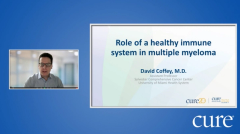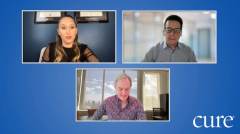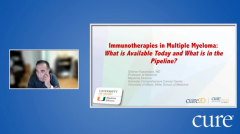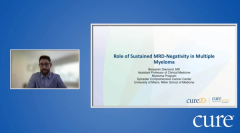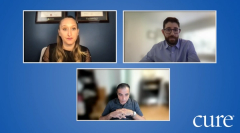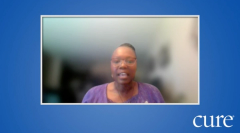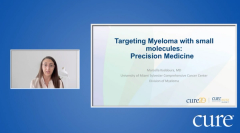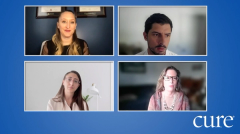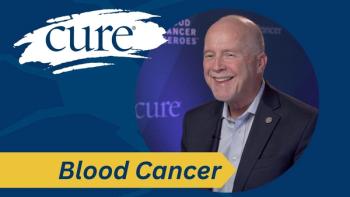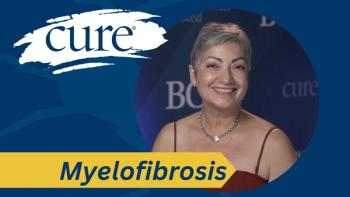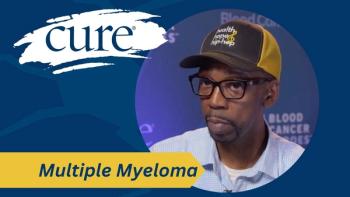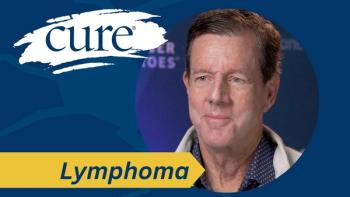
Educated Patient® Multiple Myeloma Summit Treating Myeloma Long-Term Panel: November 13, 2022
Watch Valarie Traynham, of the HealthTree Foundation, discuss the long-term journey of the disease and disparities still seen during the CURE® Educated Patient® Multiple Myeloma Summit.
Episodes in this series

With over 34,000 cases of multiple myeloma estimated to be diagnosed this year, according to the American Cancer Society, each patient and their story are different, highlighting the need to find one’s voice in their journey, Valarie Traynham says.
At the CURE® Educated Patient® Multiple Myeloma Summit, Traynham, leader of the Myeloma Community African American Chapter of the HealthTree Foundation, spoke of her journey with myeloma, as well as her experience as a patient advocate who aims at addressing the disparities seen in the Black community with this disease.
Can you talk about what it’s like hitting treatment milestones in a myeloma journey, and moreover, the milestones beyond treatment?
Hitting those milestones, for me, is a blessing. It’s a time to reflect, reminisce (and) celebrate. With each milestone I come across, I try to take the opportunity to think about and look back on how I have come through those things, and it’s an opportunity to celebrate. You take the opportunity to appreciate the importance of life and enjoy every minute of that.
I recently celebrated a milestone birthday, (which) was particularly important to me because when I was diagnosed seven years ago, I didn’t think I would ever live to see that I celebrated my 50th birthday. … So that was one of those milestones that was really important, and I made the most of it. I celebrated big time with that.
Can you talk about why it’s important to seek support, and then further, get involved in the myeloma advocacy space?
It’s important to seek support from others, particularly those who understand what you’re going through or what you could be facing along the way. We’re living longer with multiple myeloma, and if you’re like me, you want to know what to expect down the road. So seeking the right support from those who have been on that journey (and) can give you a sense of hope — they can also help you cope.
When you’re dealt the myeloma hand, it’s something you probably don’t expect, and you don’t know how to react. There’s anger, disappointment (and) a grieving process of grieving things you thought you’d be able to do. There’s (also) the feelings of loneliness you may experience, and finding the right support can help you cope in all those areas.
The support I received helped me feel somewhat in control of the situation. Now, I have no control over the multiple myeloma, but I want to do whatever I can to keep as much control as I possibly can. So seeking support from others, learning from others and gaining that knowledge helps me in that sense, that I do have a little control over the situation.
When it comes to a myeloma journey, why is it important to make sure patients’ voices are heard?
The patient voice is very critical. The patient voice essentially helps to establish partnerships that can provide evidence-based care that is responsive to individual patient preferences, patient values, etc. When it comes to (using) your voice, we have to do it, and it’s through simple means.
It may not be as hard as we think it is. … Some simple things you can do — and these are things I did along the journey that helped me — are speaking up if something wasn’t clear and ask questions. You have the right to ask questions, and you have the right to receive a clear answer. Don’t walk away thinking, “Oh, it wasn’t that important,” or “I’ll just figure it out next time.” Ask those questions. If your doctor doesn’t have the time right there to answer those questions, stick it out. … Come to your appointments with some questions written down.
We often get into that chair, and we’re sitting there with the doctor, and it (feels) like, “Oh, God. I had so many things I wanted to ask, but I forgot.” So just come in prepared, having something written (down). And be honest with your health care team. Tell them how you’re feeling. They can’t help you if they don’t know how you’re feeling. I also say be specific when you are describing how you are feeling. (If) you’re having some pain, be specific (about) how that pain is affecting you.
In line with having your voice heard, we’re still seeing challenges and disparities in myeloma. Can you talk about these disparities, particularly within the African American community?
Within the African American community, we’re still seeing those disparities when it comes to delays in diagnosis. Patients are having to go back to the doctor for the same issue, whether it’s reoccurrence, back pain or just general fatigue. We know multiple myeloma comes with fatigue. So (we’re seeing) delays in diagnosis. We’re also seeing barriers that could be due to socioeconomic status. We know that leads to poor outcome.
We’re still seeing barriers when it comes to stem cell transplant. African American (patients) do receive stem cell transplant, but it’s not (always) offered up front. (Often), African American (patients) are referred later in the process for a stem cell transplant. Sometimes they aren’t told about it at all.
I look at clinical trial participation, (and) we know the clinical trial participation for African Americans (with) myeloma is very low — 68%. We can do better. A lot of it is lack of awareness. A lot of the past medical injustice that African American (patients) have faced is just issues with communication, so we have a lot of work to do in that particular area.
You’re involved as an advocate, with a focus on addressing these disparities. Can you discuss your efforts and any resources available for our audience?
I like to use my voice to bring awareness to those disparities I just spoke about. And one thing I do that I really enjoy is leading the (Myeloma Community African American Chapter of the HealthTree Foundation). We connect (patients, and) we provide support resources and education to the Black myeloma community. We cover specific issues from (the perspective of) Black (patients with) myeloma.
Some of the things we cover are how to be your own best advocate. We often talk about being your best advocate, but what does that look like? How do you do that? We talk about things, (such as) clinical trials from the patient perspective. I welcome doctors to answer the questions the Black myeloma community has when it comes to clinical trial participation (and) stem cell transplant. We (also) talk about the financial challenges African American (patients) face when it comes to multiple myeloma.
Along with that, I have the pleasure of leading the Black Myeloma Health (African American) Facebook Community Group. (As) African Americans, we want to know that we can talk freely (and) ask questions. So (this is) a trusted space where African American patients, their caregivers, family members (and) kids can come to get patient resources, ask those questions, seek support — (including) inspirational support — (and) get encouragement. We also talk about those disparities we just mentioned, and I think talking about them is the start to finding solutions. When we’re all involved in finding those solutions, it makes it a little better.
We’re making strides in addressing disparities, but what more can we be doing?
We are making strides, but we can always be doing more. One of the things we could be doing more of is community engagement, getting down into the community and building trust, or rebuilding trust, in a lot of areas there. I also think we can educate communities and patients about multiple myeloma. There (are) so many (patients with) multiple myeloma (who) don’t fully understand the disease or have a great understanding of how it affects the African American community at two times the rate of other communities. So I think it’s that awareness piece — educating patients and communities.
But I also think it involves educating primary care physicians, (who) are the first line that see these patients. A lot of them aren’t aware of the symptoms of multiple myeloma. We have to educate those physicians on what multiple myeloma looks like, particularly what it looks like in the Black population, (so) when they do see (these) patients, they are aware that this could be multiple myeloma.
On that same note, when it comes to educating the community … about the signs and symptoms of multiple myeloma — if you are experiencing those signs and symptoms and you’re going to the doctor, ask your doctor, “Could this be multiple myeloma?” You have to know what the signs and symptoms are to be on the lookout for them. I think we can do a lot more community engagement, educating the community’s patients (and) educating the primary care physicians.
Looking back to your precancer self, what is one thing you wish you knew about having an active voice in your journey?
That my voice matters. I’m just a (patient with) myeloma — one of many — but my voice matters. Always know that your voice matters. Your story is unique. We may all have multiple myeloma, but we’re all different. So, your voice matters and know that whenever you have the opportunity to share multiple myeloma with someone, do it, because there’s so much power in that.
Transcription edited for conciseness and clarity.
For more news on cancer updates, research and education, don’t forget to

